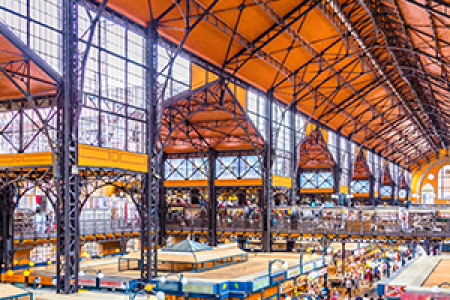April 1, 2021
E-commerce is dominating the retail space. This presents new challenges and opportunities for e-commerce retailers, especially when it comes to logistics processes. To remain competitive and simultaneously meet consumer expectations, e-commerce businesses are racing to optimize warehouse and distribution operations before they get left behind.
We’ve seen a rapid spike in global e-commerce sales over the past year, and all research surrounding e-commerce trends seems to reach the same conclusion: The e-commerce market will continue to grow for the foreseeable future, and the most successful e-commerce logistics strategies will determine which e-commerce retailers end up on top.
E-commerce trends are undoubtedly shaping e-commerce logistics trends. Today, a successful e-commerce logistics strategy is achieved by understanding consumer demands and using that knowledge to drive strategic decision making throughout the entire value chain.
We’ve identified four defining trends in e-commerce logistics that have emerged in response to consumer-led e-commerce trends:
3. Sustainable E-Commerce Practices
4. Growth in Subscription-Based E-Commerce
Continue reading to learn more about consumer-led e-commerce trends and how these trends are influencing e-commerce logistics in a highly competitive market.
What Is E-Commerce?
This may seem like a straightforward question, but e-commerce is actually a broad term. E-commerce is most often associated with the sale of a consumer product through an online store, but it’s much more than that. E-commerce refers to all electronic trade and includes both goods (products) and services:
Business-to-Consumer (B2C): For example, a consumer purchases a laptop from BestBuy’s website or rents a moving truck from U-Haul. Marketplaces (e.g., Amazon) also fall under the B2C category.
Business-to-Business (B2B): For example, a company purchases office supplies from a wholesaler or purchases web-EDI from a service provider.
Consumer-to-Consumer (C2C): For example, a consumer purchases a used car from a private seller on Craigslist or a handmade mug from Etsy.
When we’re talking about e-commerce growth, we’re including all three categories listed above: B2C, B2B, and C2C. There’s significantly less pressure on C2C market participants, so we we’ll end that conversation here. So even though B2B e-commerce is on the rise, it’s the B2C category that’s defining e-commerce trends in today’s market.
Following the onset of the coronavirus pandemic, more and more consumers have realized the convenience of online ordering, and this has highly contributed to e-commerce growth. In fact, in just the first half of 2020, we’ve seen an increase in e-commerce growth equivalent to that of the past 10 years. That being said, it’s no surprise that consumers are in dictating the future of e-commerce.
As we’ve already mentioned, it’s consumer-led e-commerce trends that are shaping trends in e-commerce logistics. It’s important to recognize these trends when determining your e-commerce logistics strategy, so here’s a non-exhaustive list of what today’s consumers are demanding:
- Fast, free, and transparent shipping
- More options (e.g., Buy Online Pick Up In Store (BOPIS))
- Free, easy returns
- Competitive price
- No waiting—products are available now
- Environmental consciousness
What Is E-Commerce Logistics?
Contrary to popular belief, e-commerce logistics is not just the delivery of a product from where it’s being stored to its final destination. Rather, e-commerce logistics is much more complex and can be thought of a mature variation of traditional logistics. And if it isn’t already implied, e-commerce logistics only pertains to online and omnichannel retail trade.
To elaborate, e-commerce logistics can be broken down into several components:
1. The movement of raw materials and (partially) finished goods in procurement and production, involving many stakeholders at various tiers in the supply chain
2. The internal movement of finished products for inventory management purposes, involving retailers, warehouses, and/or distributors
3. The movement of finished products to end customers, involving retailers, warehouses, distributors, and/or third-party logistics (3PL) providers
For each of these components, top e-commerce retailers are mapping each process back to one or more consumer-led e-commerce trends to determine their overall e-commerce logistics strategy.
This approach can be narrowed down to five market-defining trends for e-commerce logistics:
Trend 1: Omnichannel Retail
E-commerce has exploded, but physical stores have suffered huge losses due to COVID-19. This is especially true for smaller retailers that relied on physical stores and in-person shoppers. These retailers have had to make the shift to online in order to survive, while larger retailers had to seriously up their game to rise above their competition.
This year, retailers have merged online and offline to a much larger extent than they have in the past and will likely continue to do so. Many larger retailers were already well on their way to providing a seamless omnichannel experience for their customers before the pandemic, but a growth in e-commerce sales has created a massive opportunity for these retailers to expand their omnichannel reach.
Over the course of the last five years or so, many retailers have introduced the Buy Online Pick Up In Store (BOPIS) model, with many offering a similar model for returns—this is nothing new. Today, major players are taking this to the next level, continuously looking for new ways to merge the online and offline experience. One example of this is for a retailer to create a personalized shopping experience in physical stores via data collected by digital channels—but that’s a whole different ballgame.
All in all, as online and offline channels become increasingly intertwined, new logistics challenges present themselves. With more options for consumers comes more possibilities for storage and delivery, creating an unpredictable logistics path with additional complexities. A flawless inventory management approach therefore becomes critical to sustaining an omnichannel retail model and realizing a successful e-commerce logistics strategy.
Trend 2: Fast, Transparent Delivery
Speed and transparency is a must in e-commerce logistics. Consumers want to receive their order as quickly as possible and they want to know everything about their upcoming delivery. This means providing real-time visibility throughout the distribution process, because it is an absolute fact that the consumer will check the status of their order at least once (most likely multiple times). Adding to this, free delivery is always preferred.
Both speed and transparency impact e-commerce logistics in that retailers have to find the most efficient, cost-effective way to meet these consumer demands. Although many retailers have traditionally chosen to manage fulfilment and shipping in-house, e-commerce growth, the omnichannel retail model, and alternative delivery options (e.g., drop shipping), has led many retailers to outsource these operations.
Today, it’s becoming more and more common for retailers to outsource shipping and fulfillment operations to third-party logistics (3PL) providers. This is often a highly successful e-commerce logistics strategy, as it’s both flexible and scalable. The biggest challenge here is deciding which company (or companies) to partner with. Once again, consumers want real-time updates. It’s important to choose partners that are capable of this.
Trend 3: Sustainable E-Commerce Practices
The sustainability trend has been around for a while, but consumers today are making it a bigger priority. All companies (not only e-commerce retailers) are under a significant amount of pressure to meet certain expectations. As a result, they’re increasingly acknowledging their environmental footprint and taking proactive steps to make their supply chain operations as sustainable as possible.
By default, e-commerce logistics builds upon a traditional retail logistics model and is, therefore, much more complex. Considering the majority of e-commerce relies on direct-to-consumer delivery, e-commerce retailers are looked at especially critically in terms of sustainable practices.
From electric vehicles to consolidated shipments, retailers are constantly looking for new, innovative ways to future-proof e-commerce logistics with a heavy focus on green means of transport.
Trend 4: Subscription-Based E-Commerce Model
Hello Fresh, Wine of the Month Club, Dollar Shave Club, the list goes on, and you’re most likely aware of countless others. Regardless of what you sign up for, the idea is the same: Receive new products and/or services each month based on a monthly subscription fee.
This sort of e-commerce business model is becoming increasingly common. In the last three years alone, the number of website visits to this type of subscription service has increased by 300%. In terms of logistics, a subscription model offers endless advantages for retailers. For example, monthly sales, stock, and deliveries can be, to a large extent, predicted with pristine accuracy.





